I began using chalk paint to refinish furniture nearly seven years ago. At the time, there was little information available about how to do it all, so much of my learning has been trial and error (often times a little heavy the the “error!”)
I’ve been chalk painting and using BB Frösch for so long, that I forget not everyone knows about the magic! Every day I get so many questions that I figured it’s time for an all-inclusive FAQ post with the top 20 most asked questions about chalk painting furniture.
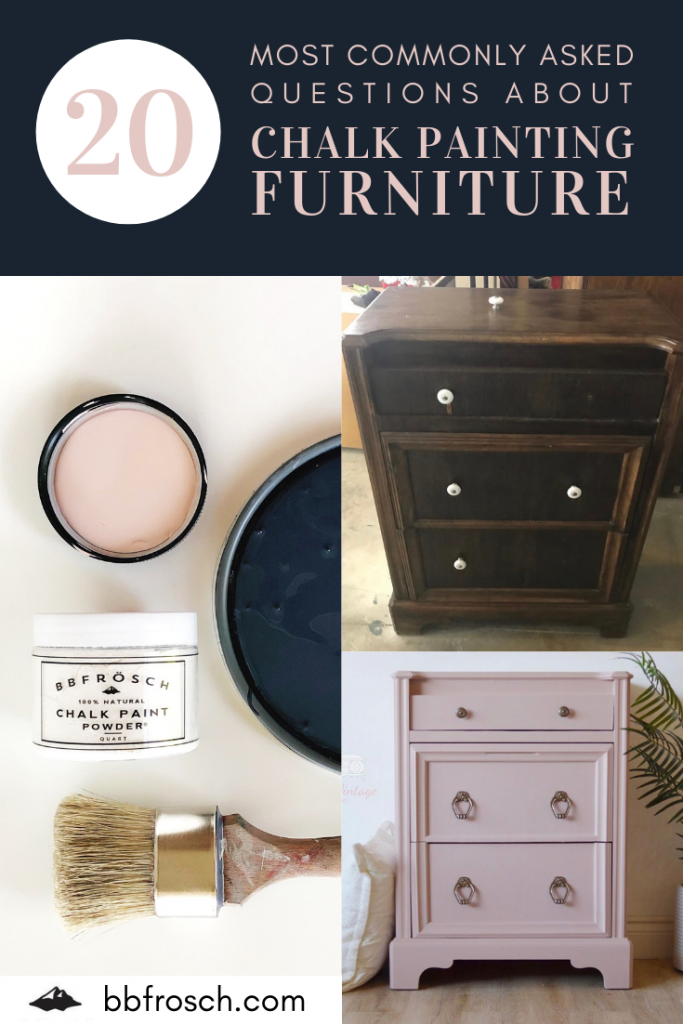
1. What is Chalk Paint? What is BB Frösch?
Chalk paint is NOT the same thing as chalkboard paint! It is a special type of paint that bonds to virtually all surfaces (wood, metal, laminate, fabric, tile, linoleum, and more!) with limited prep work—i.e. no sanding, stripping and priming is necessary.
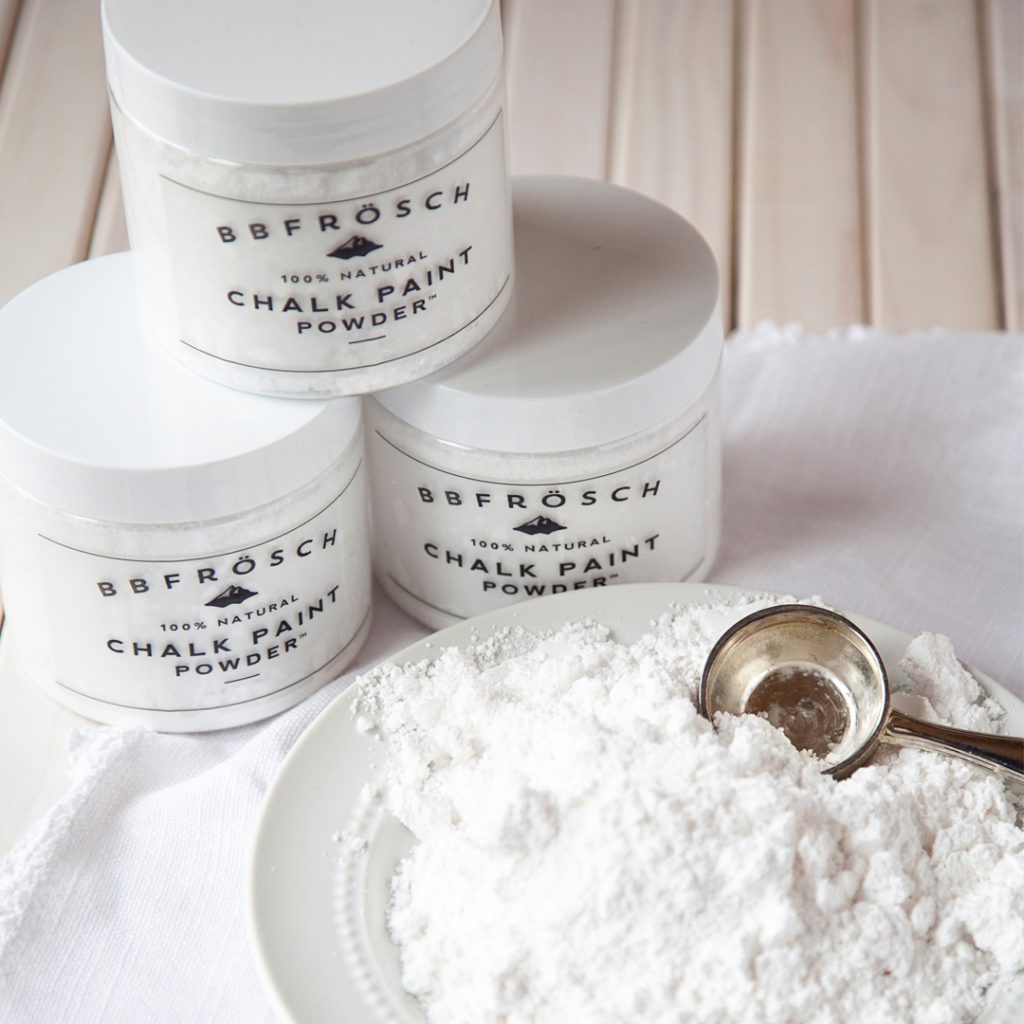
BB Frösch is the affordable and premium alternative to pre-mixed chalk, mineral and all-in-one paints. It is an all-natural mineral powder that transforms ordinary paint into rich and creamy paint with all the benefits of pre-mixed chalk paint and more—at a fraction of the cost. With BB Frösch, you get ANY color you want, and because you mix only what you need, there’s no waste!
2. What are VOCs?
VOCs (volatile organic compounds) are the chemicals that can be released into the air as paint cures. BB Frösch is completely VOC-free. Simply add BB Frösch to any brand/color of VOC-free paint for a safe painting experience (even indoors!)
3. I don’t like shabby chic, matte or “chalky” finishes. So, why would I use chalk paint?
One of the biggest misconceptions about chalk paint is that it only creates a chalky finish or that it is only used for antiques and “shabby chic” or farmhouse looks. Although BB Frösch gives paint the features of chalk paint if that’s what you’re after, it does so much more! It literally transforms any ordinary paint so that it not only bonds with all kinds of surfaces, it becomes manipulatable. That means you can distress if you want. You can even make your paint act like a stain (I call it faux stain.) If you like smooth and modern or high gloss, simply add BB Frösch to paint with a sheen or seal with a high gloss sealer.
4. How do you make your own chalk/mineral paint with BB Frösch?
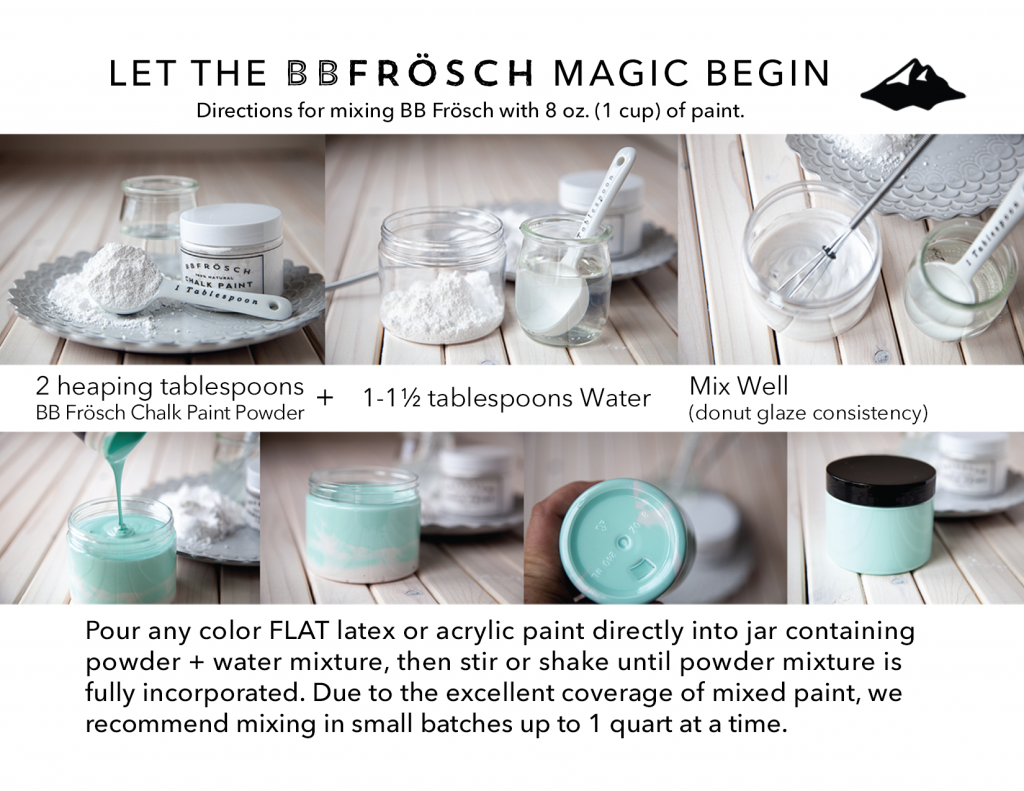
For more detailed mixing directions as well as directions for mixing larger or smaller quantities, click here.
5. What kind/brand of paint should I use?
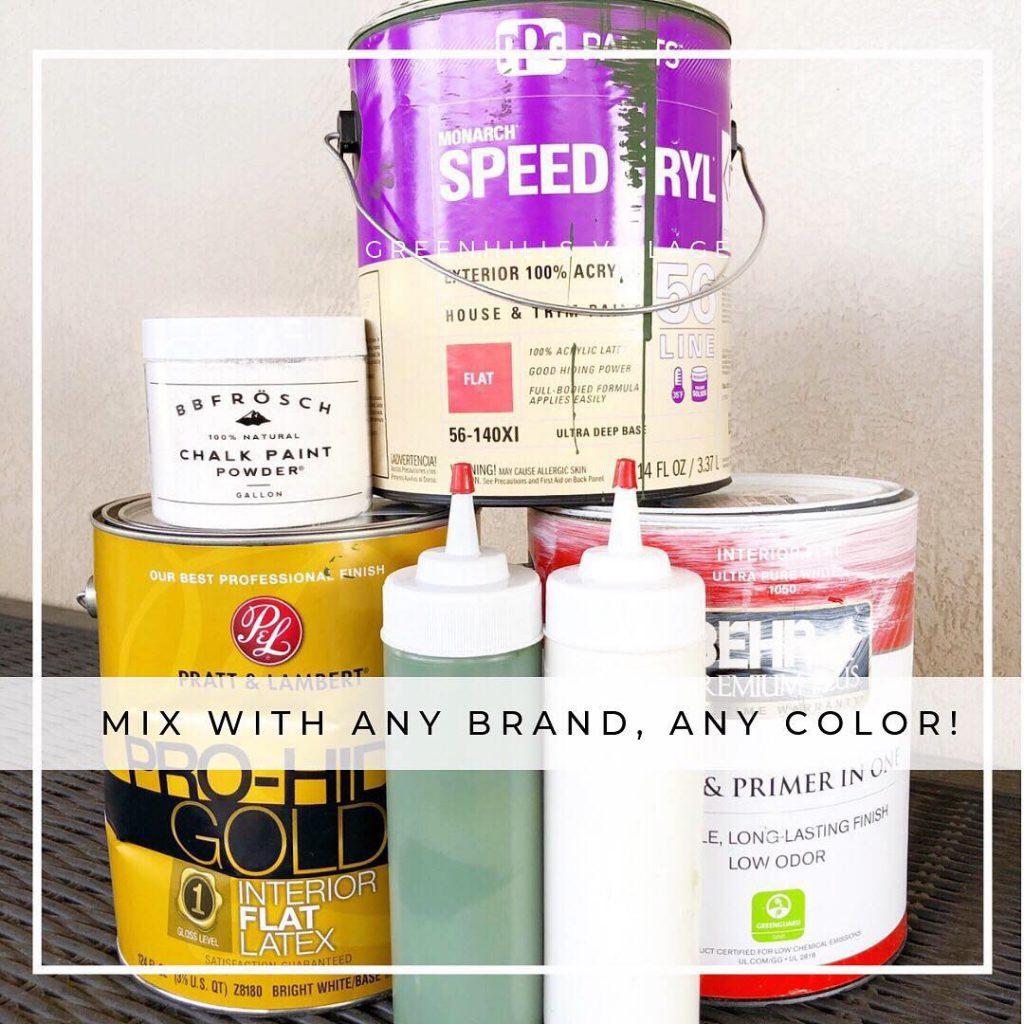
One of the best things about BB Frösch is that it can be used with ANY BRAND of latex or acrylic paint. If you want the features of chalk paint, the key is flat finish. If your paint has primer in it, that’s okay—you will still get all the great properties of chalk paint, it will just thicken a little more when stored.
Behr is a great brand for convenience because it is readily available in sample 8 oz. jars that can be tinted any color for about $3. Behr is also available with No-Voc’s.
Other brands have sample jars varying in size from 6-12 oz. but may not be available in flat finish.
I LOVE Benjamin Moore and highly recommend it. Many locations only offer this brand in a quart. However, just because you buy a quart, doesn’t mean you have to mix the whole quart. For most projects, we still recommend mixing just 8 oz. (1 cup) at a time.
If you are buying a quart, pick whatever brand you want, because they all have a flat-finish choice.
Read here for more information about using eggshell, semi-gloss and high-gloss paint.
6. Do I have to sand before painting?
The quick answer is NO. However, it’s not quite that simple. The awesome thing about chalk paint, is that you don’t have to sand (or strip or prime) before painting. However, you do need to, at a minimum, clean your piece well. This is especially important for cabinets. I do recommend sanding any surfaces that have peeling or chipping paint. You don’t have to sand all the way through to the underlying surface, but sand to at least smooth.
7. How much paint/How many coats will my project require?
While I can’t say exactly how much paint you will use or how many coats it will take, I CAN tell you that you will use less paint and fewer coats than if you were using other types of paint. Typically, 1-3 coats.
A number of factors determine how much paint/how many coats you will need:
- What color is your original surface?
- What is the original surface made of?
- How big is the project?
- What color are you painting?
- What technique and method of application are you using?
- What is the final look you want to achieve?
Read more about how determine how much paint you will need here.
8. What if my paint is too thick?
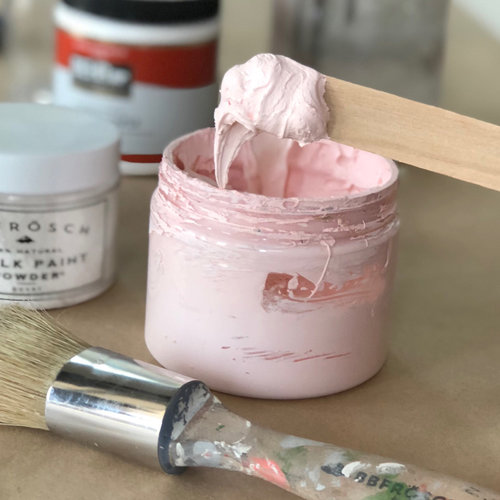
Chalk paint will thicken over time when exposed to air. To avoid thickening, store mixed paint in a tightly sealed plastic container. I don’t recommend storing paint in a metal container because corrosion of the container can contaminate your paint. I also don’t recommend glass because, if you drop it and it breaks…yikes!
Depending on how much BB Frösch is added during the mixing process, the resulting paint can become quite thick over time. Additionally, paint containing primer will also thicken when stored. NO WORRIES! Just gradually add water while stirring until the desired consistency is achieved.
Read more about how to handle thickened paint here.
9. Do I need a fancy brush?
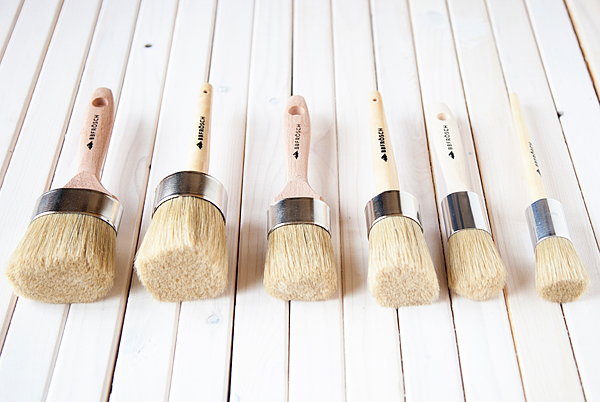
The short answer is NO! Chalk paint can be applied with any application method including a roller or sprayer. Heck, you can even use your fingers if you want! However, to achieve all the techniques and finishes chalk paint is capable of achieving, BB Frösch brushes are a great choice! Features include:
- Natural, chisel-tipped bristles aid in self-leveling properties
- Thick, oval brush head means less brush loading which cuts down on overall project time
- Dense brush head means more paint on your piece and less paint absorbed into your brush
- Wide ferrule and shorter bristle length aids in bristle stability which helps eliminate “flipping” of paint when painting in cross-hatch strokes. Bristle stability is essential for highly texted and grooved areas.
- Shorter handle makes painting in tight areas easier
- Designed to last years when treated with care. In fact, they get better with age!
Learn about the difference between paint and wax brushes here.
10. How do I avoid bristles in my paint?
New brushes should be conditioned before the first use to avoid bristles. This is how I do it: wet the brush, and swirl it in BB Frösch Brush Conditioning Soap. Rinse the brush, pulling the lather out until the water runs clear. Beat the bristled end of the brush against the edge of a counter or sink to loosen wayward bristles.
If a bristle does find it’s way onto your painted surface allow your paint to dry first, then try simply rubbing the bristle with your finger or a small piece of 400-grit sandpaper. The bristle should come off nicely without leaving a mark.
Learn how to care for your paint brushes here..
11. How do I avoid seeing brush strokes?
Some techniques utilize brush strokes to highlight the technique (two-color distress, for example.) So, brush strokes are not always a bad thing! Brush strokes are also more authentic for antiques and older pieces, so don’t be completely opposed to them.
However, if you don’t want to see brush strokes, there are a couple of steps you can take:
- Use a chalk paint brush.
- Kiss your brush with water before loading paint.
- Paint initial strokes in cross-hatches. This will give subsequent coats of paint something to settle into. Painting with the grain on all coats can actually make strokes more visible. If you want to paint with the grain, just do so on the final strokes/coats.
- If you absolutely want to avoid brush strokes at all costs, apply your paint with a sprayer. I prefer the Homeright Finishmax sprayer.
12. Do I have to Wax? Can I seal with Polyurethane? Or something besides wax?
Yes.
All furniture and cabinets should be sealed for protection after chalk painting. If not, water, distressing, oils, and dirt could damage the surface. I recommend sealing with BB Frösch Premium Finishing Wax.
Though any paint sealer will work with chalk paint (polyurethane, polyacrylic, lacquer, etc.), I prefer wax for nearly every chalk painted project…learn more about the pros and cons of wax and poly here and here.
13. Can I paint over a previously waxed or poly’d surface?
Absolutely! Make sure any chipping or peeling of the existing surface is removed or at least smoothed with sandpaper first. If the surface is particularly glossy, it helps to scuff it first with a coarse grit sandpaper. If the surface is a shiny wax surface, it helps to use mineral spirits to help take down the shine so paint can bond better. Lastly, add a little extra powder to your paint to aid in bonding to a previously finished surface.
14. How do I clean a waxed surface?
I recommend simply cleaning with a damp cloth. Mild cleaners like Greenworks also work well.
If you happen to remove or dull a waxed surface from cleaning with too strong of a cleaner, simply re-wax the affected area.
15. Do I have to re-wax over time?
Re-waxing is typically not necessary. If you find that a waxed surface has dulled over time, usually just buffing with a cloth will bring the shine back.
If wax becomes removed through weathering, heavy use or cleaning, re-waxing may be necessary. There is no need to strip the existing wax first—just apply, remove excess wax, and buff the same way you did with your original application.
16. What causes paint to lift and how do I avoid it?
Chalk paint has the amazing ability to be manipulated. One of the ways it can be manipulated is with water! Before chalk paint is sealed, it can be removed by rubbing with a wet cloth or brush. This is highly desirable for several finishes and techniques including wet-distressing.
This means that, especially on more smooth surfaces (laminate, glass, tile, etc.), applying a second coat of paint can “lift” the first coat. Why? Because the stiffness of the brush bristles combined with newly introduced wet paint can re-activate underlying layers.
You can avoid this by making sure the first coat is fully dry. Even though chalk paint dries quickly, it can take up to a day to cure. For particularly smooth and less-porous surfaces, you may consider allowing the first coat to cure beyond the typical dry time. Additionally, when painting subsequent coats, be sure not to overwork your brush.
17. Can I paint laminate?
Paint mixed with BB Frösch Chalk Paint Powder bonds with virtually any surface. including laminate. However, there are extra steps you can take to aid with bonding to particularly smooth or challenging surfaces like glass, laminate and metal.
For surfaces other than glass, scuff the surface a bit with sandpaper (60-100 grit works well.) You don’t have to sand through the entire surface, just scuff enough to give paint a little something to bond to.
Add additional powder in the mixing step–double the powder, even! The more powder, the more bonding.
Get more tips for painting laminate here.
Check out these painted laminate examples:
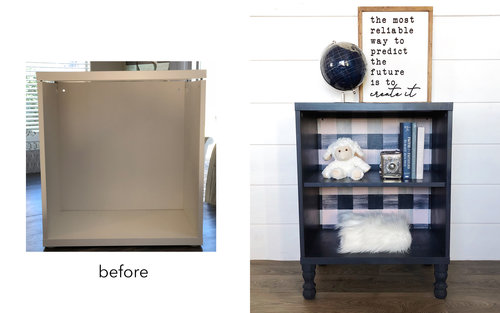
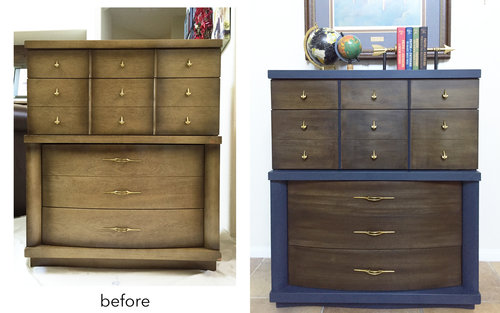
18. What is bleed-through, and how do I avoid it?
Bleed-through is caused by tannins which are basically water or solvent that has been trapped within the wood at some point. This is more common with older pieces, but it doesn’t happen often. Unfortunately, there is no way to know ahead of time if tannins are present.
No amount of paint, regardless of brand, will cover it. Solutions include:
- Sand through to just below the original surface. This can be done on just the areas where you see bleed-through—the whole piece doesn’t have to be sanded.
- Use a product like Kilz over the area where you see the bleeding. This solution is much easier, but if you want to distress your finished work, you won’t be able to distress through to see the underlying wood.
- Prior to painting, use a product like shellac or polyurethane over your piece. This solution is more of a preventative measure that many refinishers automatically use on antiques. It allows you to distress and see the underlying wood, but be sure to use water-based, not oil-based, or yellowing can occur.
19. Can I paint my cabinets?
GO FOR IT!
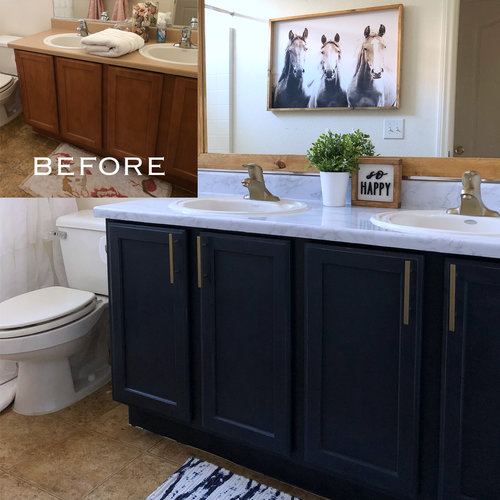
I recommend taking the Ultimate Guide to Painting Cabinets online workshop (use code ALLTHINGSTHRIFTY for 25% off.) In addition to valuable tips and tricks that will save on frustration while building confidence, you will learn several methods for painting and sealing so you can best decide which approach(es) meet your needs. All this in an online setting that will help make a project like this enjoyable and professional looking.
20. I feel overwhelmed trying to read every blog post under the sun. How can I get more in-depth instruction for my specific project?
I get it! I remember feeling the same way! I’ve written blog posts for everything from painting pianos to painting floors. But, it can be challenging to wade through all the info to get just what you need for your specific project. It’s one of the reasons I created BB Frösch University with three different courses for all things chalk painting: The Ultimate Guide to Chalk Painting, The Ultimate Guide to Painting Cabinets, and How to Paint Vintage and Antique Furniture.
There are several more courses in the works and coming soon:
- How to Make Money Flipping Furniture
- How to Repair Furniture
- How to Paint a Piano,
- How to Photograph and Stage Furniture
Use code ALLTHINGSTHRIFTY to receive 24% off any of the current courses at BB Frösch University.
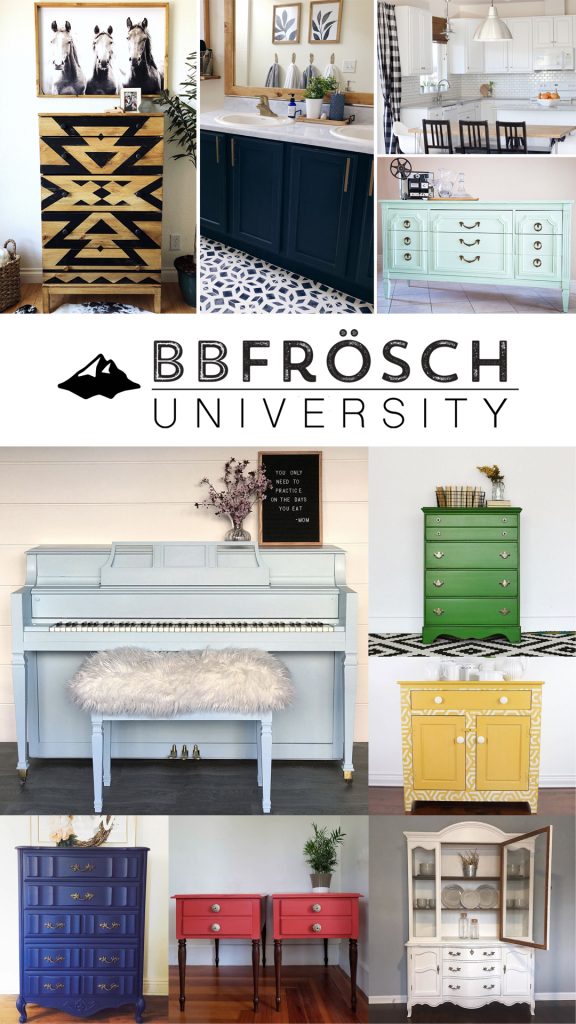
Follow BB Frösch on Instagram, where you can find more affordable chalk painting makeovers (like cabinets, floors, furniture, and more!)
Find more affordable chalk paint inspiration at bbfrosch.com. Follow BB Frösch on Pinterest and Facebook.

totally saving this for later! We have a lot of painting projects coming up!
Paige
http://thehappyflammily.com
I am new at this and have done two cabinets and I’m in love!! Question, I, hastily , painted something linen white, And than realized that what I really wanted was off white. I haven’t waxed yet, can I do a third coat??
Hi Lisa!
Go ahead and paint the off white right over the linen white! Then be sure to seal.
Kristin
I painted a cabinet. The tops and side were black and I painted white chalk paint 2 coats and sanded. Turned out nice.
The drawers and door on front were brown and I also did 2 coats white but when I sanded it the brown showing thru doesn’t look good with top and sides.
Can I paint over it with black latex and then chalk paint again and sand? Or remove the chalk paint and then paint black?
Thank you
Janet–
If I understand correctly, when you distress to let the underlying color show through, you don’t like the brown…you would rather have black show through when you distress. No need to remove the white you painted. You can just paint over it in black, then paint white again and distress through to the black. Don’t distress too much, though, or you’ll go through to the brown. I hope this helps!